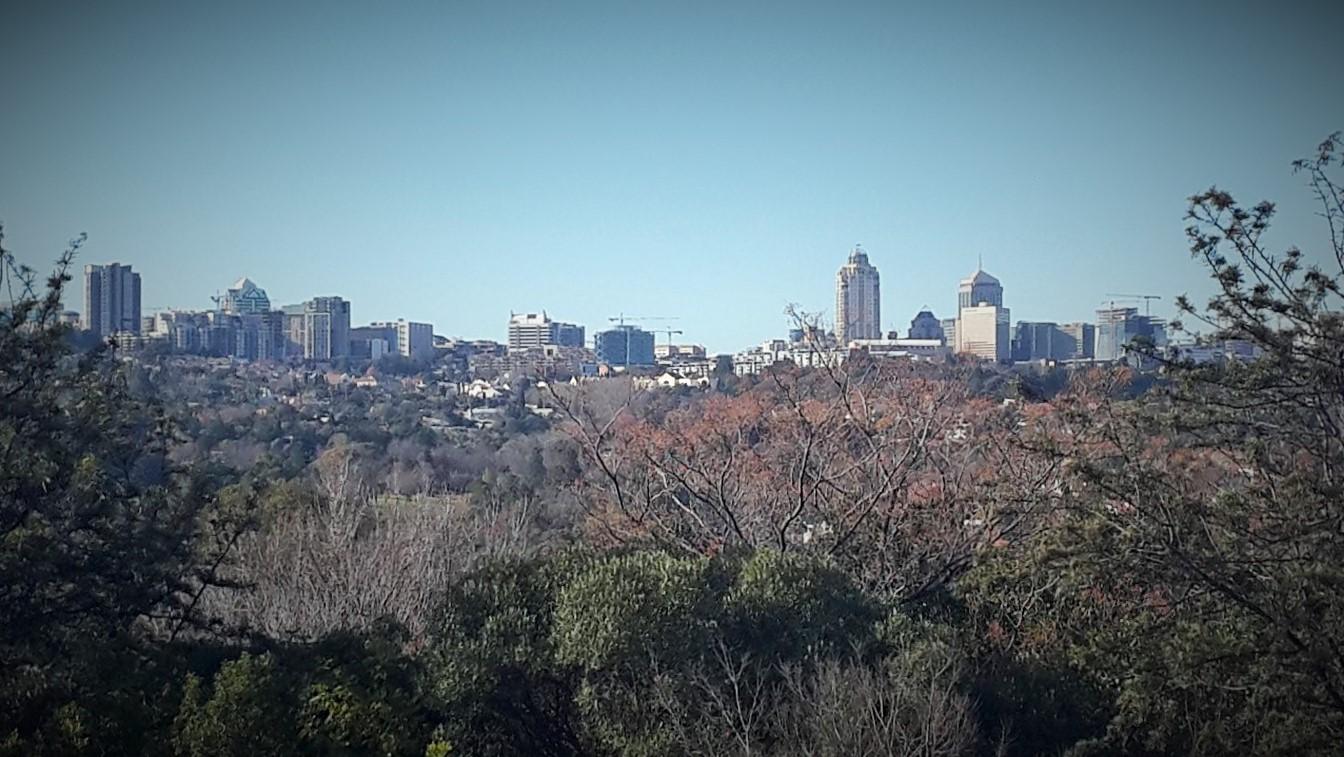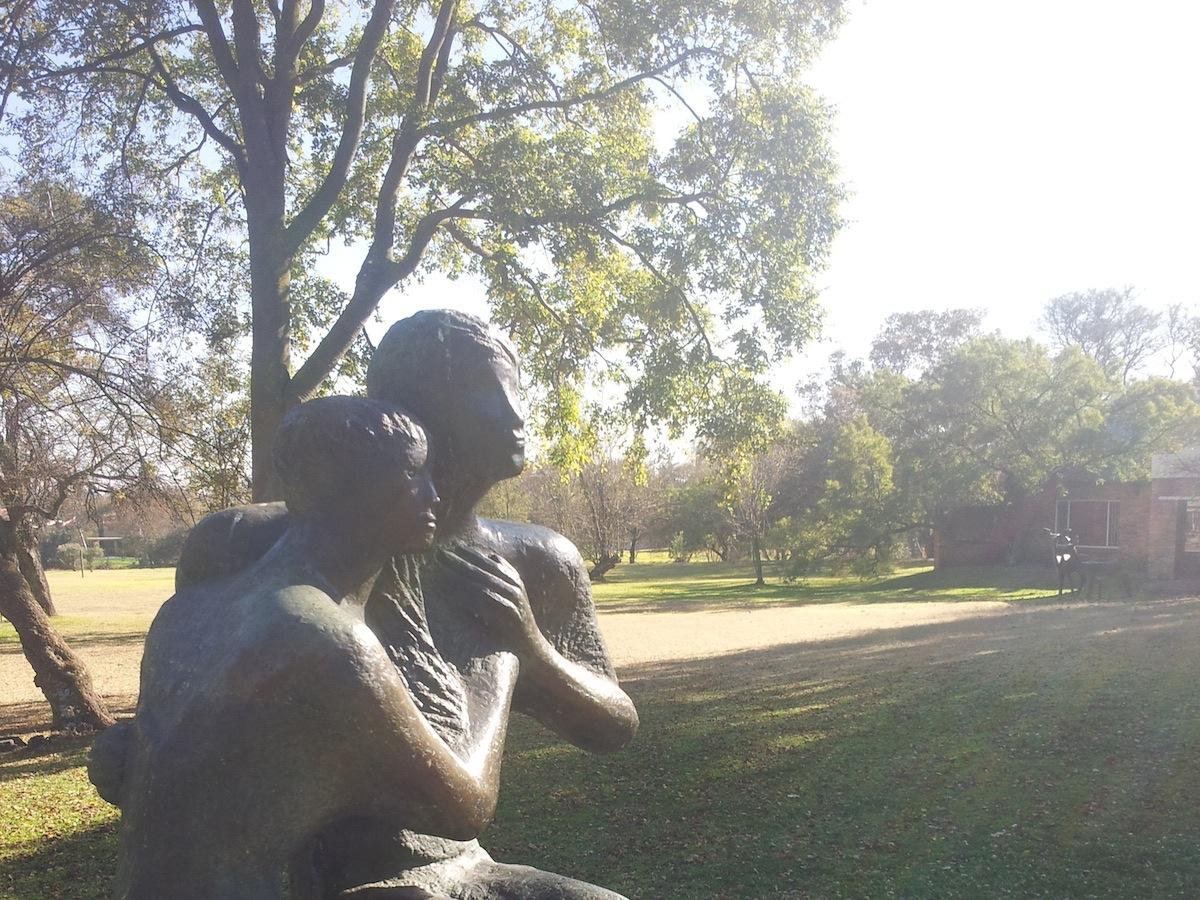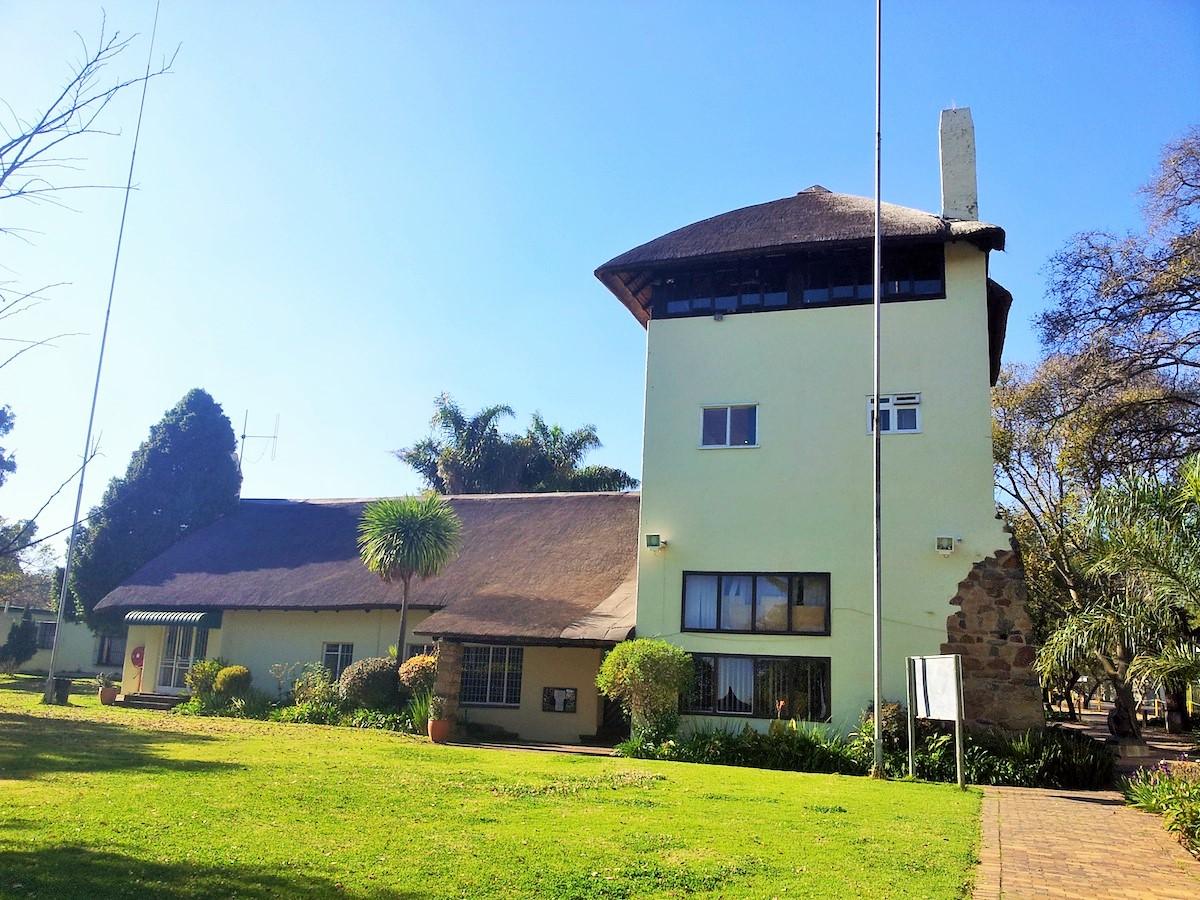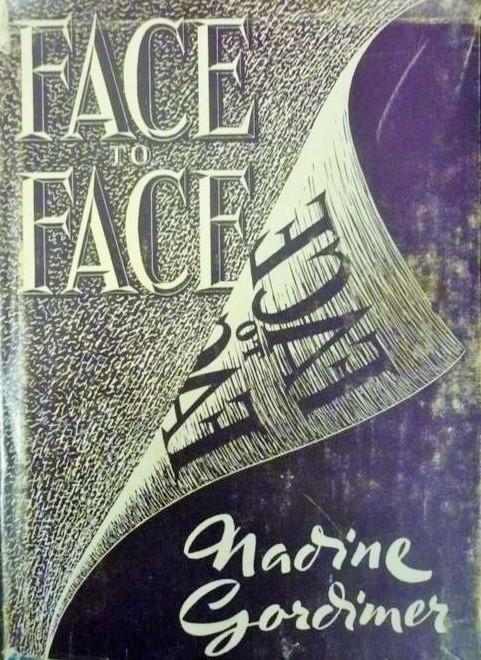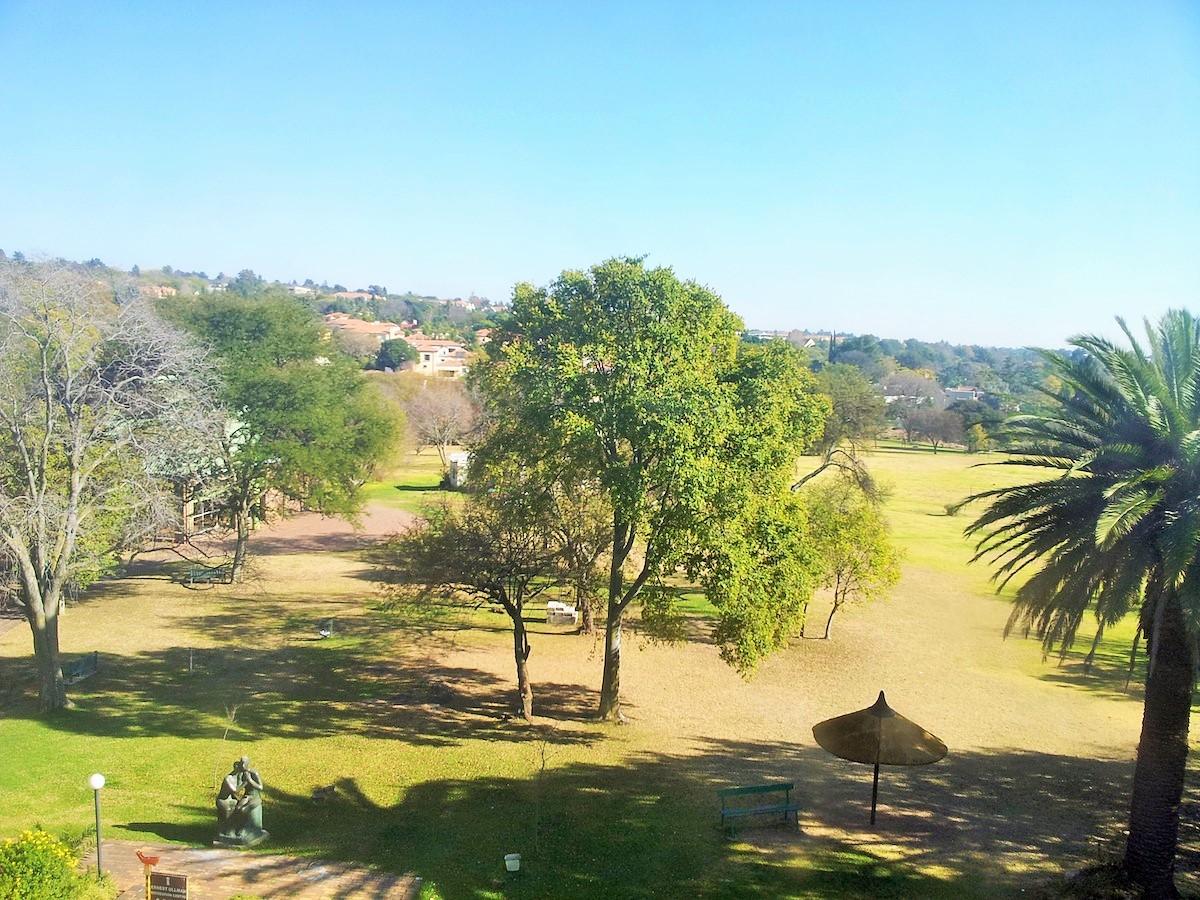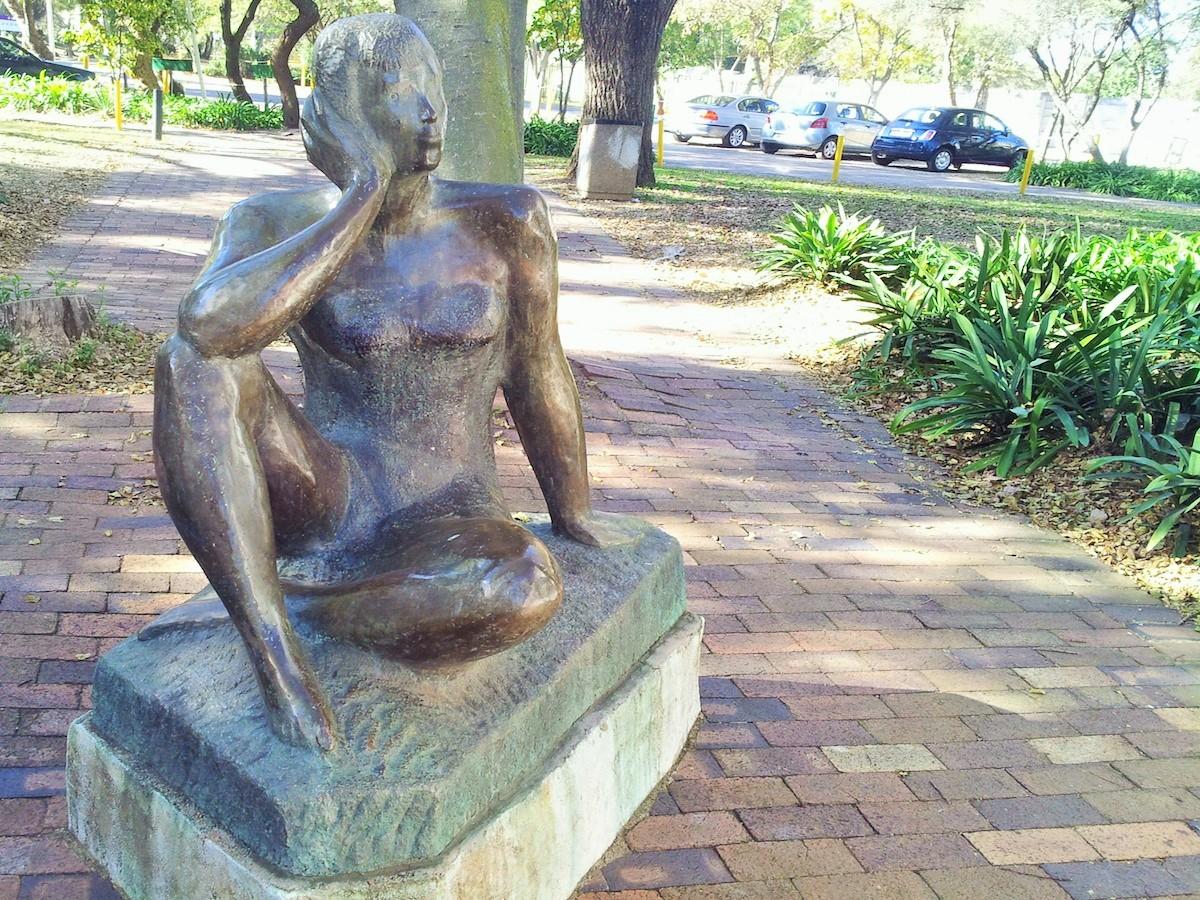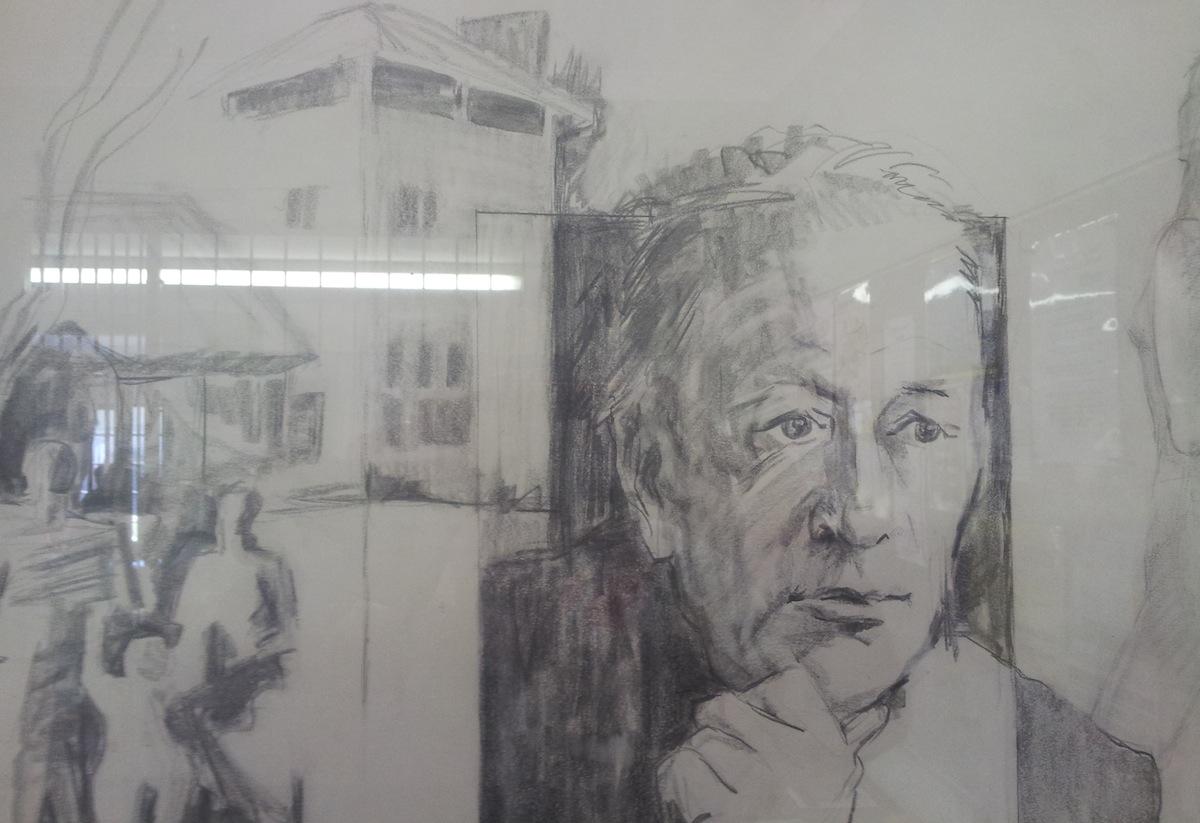
Disclaimer: Any views expressed by individuals and organisations are their own and do not in any way represent the views of The Heritage Portal. If you find any mistakes or historical inaccuracies, please contact the editor.
In the early 1980s Derek Jooste put together this fantastic article on the life of iconic artist, sculptor and designer Ernest Ullmann. The piece was originally published in the journal of the Sandton Historical Association.
Sandton is too young to boast a Hall of Fame. It has grown too quickly and its people have forgotten to look back. What was a cluster of farms only thirty years ago, is now a fast growing town. The people who inhabited those farms are the forefathers of Sandton and we must look at their lives in an attempt to reveal the town’s cultural heritage.
A fast growing city (The Heritage Portal)
Ernest Ullmann’s work adorns so much of our urban landscape. Indeed, a visitor, or a newcomer visiting out Civic Centre for the first time will immediately notice two of his sculptures set in the grass outside the building – one of a horse, and the other depicting some buck. In fact, the Civic Centre has a grand store of Ullmann’s sculptures, maquettes and tapestries, some hidden behind the leaves and the pot plants, some in official corridors and luckily some in public view as are those outside. [Alas no more]
An Ullmann Sculpture in Ullmann Park (The Heritage Portal)
Ullmann lived with his wife Jo on Fairlea Farm beside the Little Jukskei River (Sandspruit today) for over thirty years. He built the house in 1940 far from the city in a peaceful spot which is now just about the middle of Sandton. It still has an atmosphere of a farm in the ‘bundu’ although surrounded by the suburb of Morningside. Today it is called Ullmann Park and it here that people come for classes in music, art and other educational activities. The surroundings are tranquil and creative – sculptures of animals and family groups are scattered about… Ullmann’s presence pervades the estate.
Ullmann House (The Heritage Portal)
Ullmann was born in Munich in 1900, and died in 1975. From an early age he showed an interest in art. One of his earliest murals was carved on the beam of a wooden bridge over the Rhine on the Swiss border. He was five years old, and the subject was a horse. His father carved the date next to it, and it is still there today. He spent a happy childhood in Munich and recalls in his Autobiography, Designs of Life, published in 1970, that his ambition was to become either an artist or a beer-wagon driver!
At the outbreak of World War I Ullmann worked in a locomotive factory, - a form of national service the youth could volunteer for. His first art post came during this period, when he was appointed as assistant-artist to the director of the Anthropological Institute of the Munich University. He acquired a sound knowledge of anatomy.
He matriculated after the war and enrolled at the University of Munich to study History of Art and Philosophy, and then at the Academy of Fine Arts to study drawing and sculpture. The economy had collapsed and Ullmann had to find a way to supplement the family income and pay for his studies. Perhaps these circumstances determined the nature of Ullmann’s development primarily as a designer. He illustrated articles for magazines and newspapers and modeled at the academy. He became part-time editor of the Auslandpost (founded by the painter Franz Marc’s brother Paul) and drew political portraits and caricatures. He painted with Stanislav Stuckgold, a pupil of Matisse and friend of Rudolf Steiner, whom he met through him.
Ullmann contracted tuberculosis after a painting trip to Italy. He spent six months at a sanitorium in Switzerland where he became conscious of the closeness of death. On his return to Munich, he completed several life-size figures in clay but felt that Munich had lost its vitality as an art centre. He wanted to get away. He went to Berlin where he joined the Wertheim Group, the largest department stores in the country. He accepted a position within the organisation as Art Director of ‘Globushaus’, a printing and publishing company. His talent was recognized and he did much work during this period. He designed dust jackets and illustrated books. He became independent, designing posters. Then he became art director of the Mitropa Zeitung and drew caricatures and was something of a celebrity during the 1930s.
The happiness and productivity of this period was shortly to be followed by the increasing influence of Nazism. As designer for many public organisations, he was frequently in contact with the new order. Life became restricted. “As a Jew, I had already been forbidden to work any longer in my profession, being informed by open postcard that I was not fit to contribute further to German culture”. His friends tried to persuade him to stay, but since he had to have a ‘ghost’ artist to sign his sculptures, some being left unsigned, life became unbearable and he decided to leave Germany (the year was 1935).
The first choice of a new country, England was barred to him. Unemployment was high and he was unable to get permission to work there. He would have liked to go to Paris, but he felt that the ‘Thousand Year Reich’ would eventually dominate all Europe. He did not care much for restricted quotas for Jewish Immigrants in the United States, South America and Australia, and as his sister had settled in South Africa some time before, he chose to join her.
Life in South Africa
He landed in Cape Town in 1936 and took a train to Johannesburg. He was struck by the vast emptiness and the waterless riverbeds he encountered on his trip through the Karoo to the Highveld. Johannesburg appeared ugly to him. He had never been in such a young town before. It was the year of the Golden Jubilee. However, his distaste turned into fascination. He describes the architecture: ‘There were miniature Greek columns supporting corrugated-iron roofs, wooden fretwork arches, fringes of lace pressed in steel to hide the crudeness of the beams, pseudo-Tudor, pseudo-Rococco, Victorian Neo Gothic, all gaily mingling with stark, ill-proportioned, cheerless and often badly copied Bauhaus style.”
As he learned more about Johannesburg and the short history of the gold-mining dorp, he began, with understanding, to develop a kind of love for it. He was later to complete a series of spontaneous drawings and paintings of early Johannesburg which were acquired by the Africana Museum to be preserved as evidence of the changing Johannesburg scene.
He felt that starving artists belonged in Paris, but not Johannesburg. He decided that his work in South Africa would be a designer, and he decided never to use the word artist to describe himself. He made an immediate impact in South Africa when he designed an overseas travel poster called ‘Mystic South Africa’. It showed two giraffe drinking at the edge of the pool. The poster was chosen as the best travel poster in an international exhibition of travel posters. Further work followed and he was offered numerous commissions of the most varied kind from murals in restaurants to sculptured fireplaces and mosaic bathrooms in private houses.
The famous poster (Gayle Ullmann)
In 1937 Ullmann was approached by RJ Kingston Russell to assist in the launching of a new magazine, The Forum. The magazine was to cover political and cultural issues and would draw its articles and discussions from the ‘best brains in the country’. Ullmann was to direct art content. He came into contact with concerned people, supporters of the liberal spirit in South Africa. During this time he met Jan Hofmeyr, Raymond the anatomist, Basi Schonland the physicist, EG Malherber the educationalist, D MacCrone the psychologist and later Principal of the University of the Witwatersrand. He also met Alan Paton, Helen Suzman and Adam Leslie.
Then he met Joyce Esson, an artist, who became first his assistant and then his wife. Together they developed their own art form known as the ‘Ullmann Tapestries’. They moved to a flat in Hillbrow and took a larger studio in Jubilee House, Simmonds Street. It was on the same floor as The Forum, so he could work on both the magazine and private commissions conveniently. However, the quality of The Forum and its independent outlook were not enough to secure its continuation in the same spirit, and Ullmann notes: “After World War II, under new management and without guidance from higher quarters, The Forum lost its character and significance. The Ullmans were nature lovers and like so many Johannesburgers liked to spend time exploring the countryside by car or on horseback. They moved from Hillbrow to Parktown North and bought two acres of secluded land for £400 at the bottom of Forest Road in Bramley. It was covered in eucalyptus trees and adjoined what is now called the Sandspruit. They began to design their own home.
Ullmann tried to enlist in the armed forces when South Africa entered the war, but was restricted on medical grounds. He joined the Educational Corps as an officer and did voluntary work for the IC Digest, the magazine published by the Army Intelligence Corps. He made a series of advertisements portraying the misery and plight of the Jews affected by the Nuremberg Laws. The committee felt that rather than publish photographs of the horror which would be too shocking for ‘John and Isaac Citizen’, Ullmann’s drawings could interpret the suffering in a more meaningful way. Accompanying the advertisements was a booklet called the Family Album.
Some of the illustrations of The Forum were made in the form of puppets and then photographed as cartoons. Ullmann started making a series of toys in a similar manner, and they established the first South African toy factory: Simba Toys. The company thrived and expanded into the field of children’s books. Simba the lion cub was the most popular. However, material and labour restrictions had become very severe and the Ullmanns reluctantly decided to sell their interests. ‘The Simba lion ceased to wag the kind of tail we approved.’
At this time (during the middle forties) Ullmann, together with AS Morley Lulu Friedman, Thelma Gutsche and others decided to start a publishing venture called Silver Leaf Books. The venture was concerned with encouraging indigenous writers and artists. The first, illustrated by Ullmann, was Zulu Paradox by Hugh Tracy. The second was a first collection of short stories – Face to Face – by Nadine Gordimer - ‘a young writer from Springs’. Ullmann was inspired by Israel’s independence. He produced a narrative of twelve large murals portraying the story of immigration, for an exhibition at Milner Park. He designed the sets for Taubie Kushlik’s production ‘Israel my People’, a pageant to mark the 50th anniversary of the Jewish National Fund.
Face to Face book cover
He acquired more large-scale, commemorative commissions in the fifties. He designed and produced a number of exhibits and pavilions for the ‘Van Riebeck Festival’ held on the foreshore in Cape Town in 1952. He was appointed as chief designer for the Union Government Pavillion at the Rhodes Centenary Exhibition in Bulawayo and received Her Majesty’s Coronation Medal from the Queen Mother who opened the exhibition.
Ullmann went to Geneva as designer-in-chief for South Africa’s exhibit at the second Atomic Energy Exhibition in 1958. A year later he began work on the Union Jubilee Exhibition at Milner Park. The theme was ‘The Union and You’. He himself chose a subject that he had used regularly and would continue to use – The Family. Ullmann’s family group was set against a background depicting the multitudes. He used an enormous variety of materials and worked with a powerful team of artists. His wife Jo created two enormous appliqué tapestries, the larger being over eighty feet by sixteen feet (+- 25m by 5m).
In 1964 the Ullmanns did a series called the ‘Brenthurst Tapesties’. Ullmann suffered a severe heart attack and spent some time recovering in the Brenthurst Clinic… to keep himself busy, he drew. Dr Jack Penn, the plastic surgeon, asked him to design a tapestry for each one of the new wards. They were to be not only artistic and attractive but should make the patients chuckle. The tapestries were finally completed and placed behind glass in each of the wards of the Clinic. An Ullmann Tapestry also hangs in the Sandton Town Council Chamber. The subject is a pagan feast with much drinking and merrymaking. It must have inspired many a smile seen in the sober context of a council meeting!
The Ullmanns had lived on Fairlea Farm from the early forties. Ernest wrote fondly of their ideal lifestyle beside the Little Jukskei River... “It was considered an adventurous move into the veld, miles away from the city. Barely three decades later, the city had caught up with us. Our little piece of land became a green, beautiful, anachronistic oasis surrounded by a desert of badly planned houses.”
He describes the deterioration of the land around them as bulldozers advanced on the old crooked houses ‘straightening out the twisted lanes of yesterday to make room for a repetitive characterlessness of new planning’.
Ullmann’s observations on the growth of Sandton paint a caricature of its fleeting adolescence. “A few hundred yards outside our gates a new suburb grew haphazardly into a conglomerate of ugliness. Little boys from there began shooting our lovely wild birds with the pellet guns. Others hunted our guinea fowl as a Sunday morning sport. Not much longer and we shall be forced to abandon a simple country life we love so much. Gone forever are the days when I rode on horseback to fetch our mail from the little post office three miles away. It is hard to be in love with nature and witness its gradual disappearance. It is a tragic bargain, - a conspiracy of ugliness, … a brutal assault on our senses. Perhaps those born in this age are not aware of it. Brought up with new vistas and surrounded by the products of the Computer Age, they have developed different sensibilities and aesthetics.
Hard words, maybe… But they came from a man who came to our northern suburbs for peace. A peace that was too short, as time and progress caught him up. Nevertheless, his Fairlea Farm is still the quiet oasis and its green fields still run down to the stream. The fact that the Council has preserved this farm as a park is at least a tribute to the man who created it.
Ullmann Park (The Heritage Portal)
The works of Ernest Ullmann that we have in Sandton are spread about, some inside and some in his green fields. Hopefully, the time will come when Sandton will have its own art museum, so that his works can be collected and displayed where more people will be able to appreciate them.
Ullmann Statue Ullmann Park (The Heritage Portal)
Comments will load below. If for any reason none appear click here for some troubleshooting tips. If you would like to post a comment and need instructions click here.

